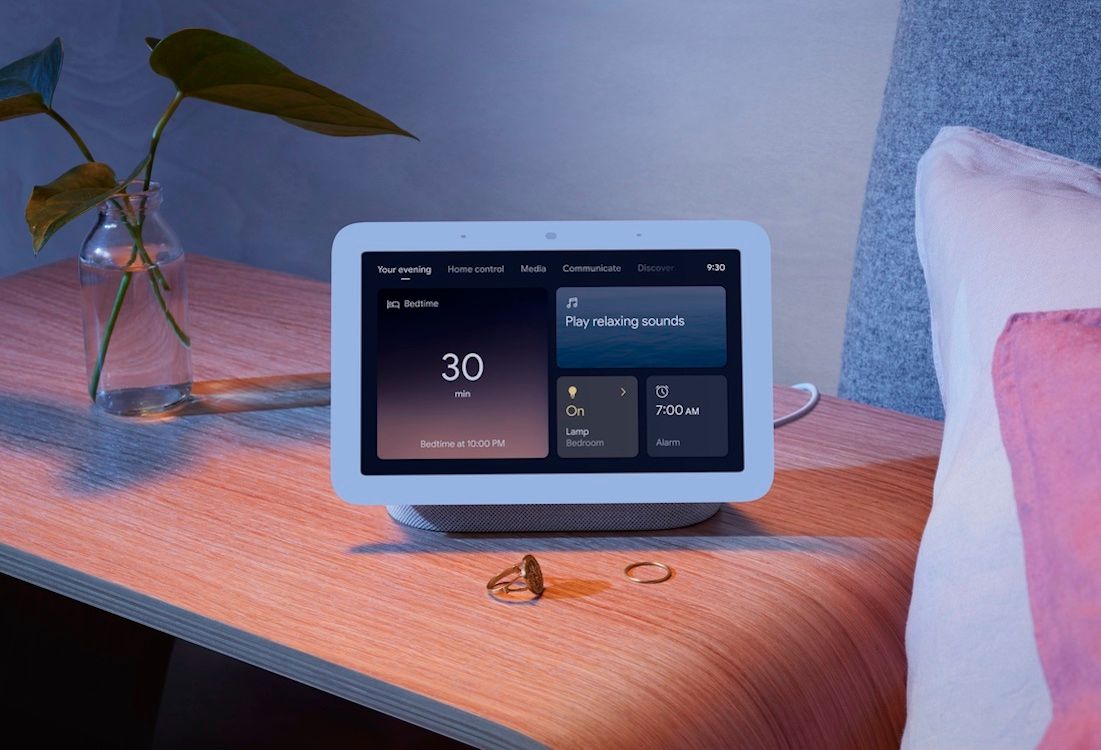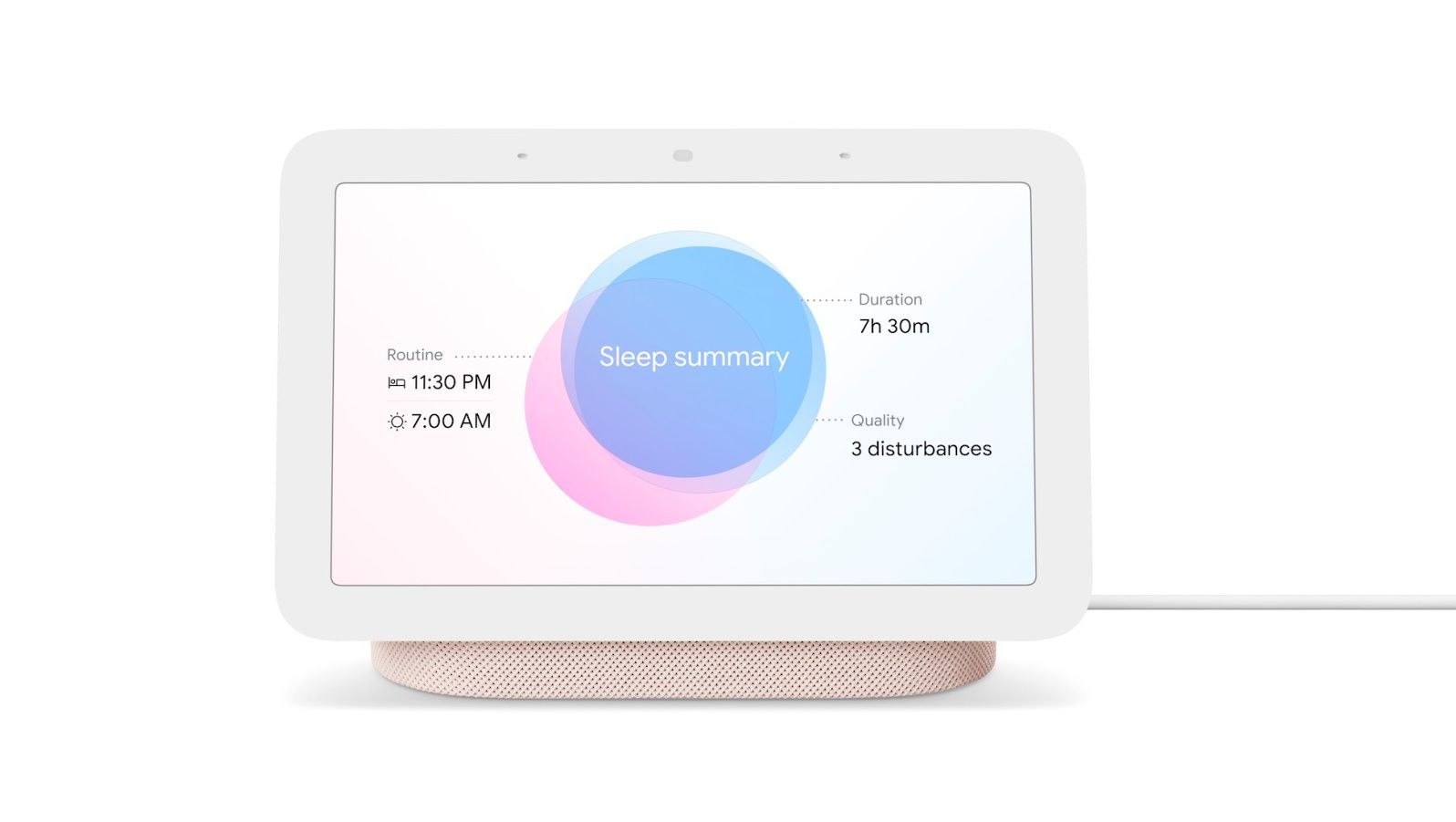Google has recently announced its second-generation Nest Hub. This improved version offers several new features over the original, including Sleep Sensing, Thread support, and upgraded audio.
We'll walk you through everything you need to know about the latest smart home hub from Google.
What Is Google Nest Hub?

The Google Nest Hub is an all-in-one smart display that works with smart home accessories, plays music and videos, and displays your latest photos. With Google Assistant, Nest Hub can also let you know who's at the door, find your next recipe, control your smart lights, and help you catch up on the latest Netflix releases.
The original Google Nest Hub debuted in 2018 and was designed to compete with video-based smart assistants like the Amazon Echo Show. The main difference between these devices and other smart home assistants is the inclusion of a screen.
This screen allows for touch and video capability, giving the smart assistant a more tablet-like user experience. Both the current generation and the second-generation Google Nest Hub feature the same 7-inch touchscreen.
What Makes the Second-Generation Nest Hub Different?
On the outside, the new Google Nest Hub looks broadly the same as the original. There are only slight differences to the externals, including the removal of the lip at the edge of the display.
This subtle difference gives Nest Hub a more streamlined appearance and may make cleaning the device easier. However, the big differences with the Nest Hub second-generation are in the internal components of the device.
The standout feature of the newest Google Nest Hub is the inclusion of Soli, a mini processor that features radar. Soli is a technology that Google first released with the Pixel 4 phone and is also found on the Nest Learning Thermostat.
In addition to Soli, Google has made two audio upgrades to the new Nest Hub. First, Google has added another far-field microphone to the unit, bringing the total to three.
Second, the audio quality on the device has also been improved. Google states that the audio quality has 50% more bass than the original.

Google has also added a "dedicated on-device machine learning chip," which allows for faster responses to many commands as the device learns your routines. Nest Hub is also made with 54% recycled post-consumer plastic.
Finally, Google has opted to include Thread radio support in the new Nest Hub. Thread technology is a communication protocol similar to Zigbee that allows smart devices to function more securely by creating a mesh network.
This technology is relatively new to the market, but companies like Apple are taking notice. Thread is also available on Nest Hub Max, Google's larger, 10-inch Nest Hub.
Thread is a part of the Connected Home over IP (CHiP) working group of the Zigbee Alliance. This alliance, made up of players like Google, Amazon, and Apple, is working to simplify the manufacturing and development of smart home products and improve compatibility between competing brands.
Adding Thread technology to the second-generation Google Nest Hub indicates that Google recognizes Thread as an essential part of future smart home tech.
Soli Sleep Sensing
Of these several new features, Soli is perhaps the most interesting. This mini-radar processing chip uses Motion Sense to track motion but does so without collecting images. This means that the new Google Nest Hub won't be watching you sleep—at least not in the traditional sense.
The device also has both ambient light sensors and temperature sensors. Within the new Google Nest Hub, Soli can detect light and temperature changes, breathing changes, snoring, and other sleep disturbances.
However, unlike other sleep-sensing devices that require wearables or cameras, Soli allows the second-generation Google Nest Hub to perform Sleep Sensing without additional equipment.
Instead, the low-power Soli chip can detect movement at all angles, allowing Nest Hub to sense an owner's location in the room relative to the device.
As you continually use Sleep Sensing, the Nest Hub will start to learn your sleep patterns. It will then use this data to recommend personalized suggestions for a better night's sleep. The suggestions will be developed with input from the American Academy of Sleep Medicine.
Each morning, the Google Nest Hub will provide a report containing information like respiratory rate, lighting changes, and other wellness details. It's important to note that the collection of sleep data is optional and can be disabled by turning off the onboard microphones. All information is kept only on the local Google Nest Hub and isn't used for advertising.
Sleep Sensing will be a free feature until sometime next year. However, it looks like the company is exploring the option of including the feature with Fitbit and Fitbit Premium. Currently, Fitbit Premium is a $10 per month subscription service.
How Much Will the New Google Nest Hub Cost?
The new Google Nest Hub will sell for $99.99 in the United States. This cost is a slight increase over the previous model, but the upgraded features seem to add enough value to the new version to offset the additional cost. Available colors will include chalk, charcoal, mist, and sand.
Pre-orders started March 16, and Google has confirmed the device's availability in Australia, Canada, France, Germany, and the UK. Major US retailers such as Best Buy will stock the product, and it will also be available via the Google Store.
When Is the New Nest Hub Available?
The Google Store only lists the Nest Hub as a pre-order at the moment, but several sources seem to point to a release date of March 30, including Best Buy.
Because this is a pre-release product, however, this information could change. Those interested in the device are encouraged to pre-order if they would like to receive their Nest Hub on the earliest possible date.
The Second-Generation Nest Hub: A Great Upgrade
Overall, the new Google Nest Hub is an upgrade over the previous version. It seems to strike a nice mix of features. And the price tag puts it on a level playing field with other smart home assistants like Apple's HomePod mini.
And if you're looking for a Google smart speaker without a screen, the Google Nest Mini is a great choice.